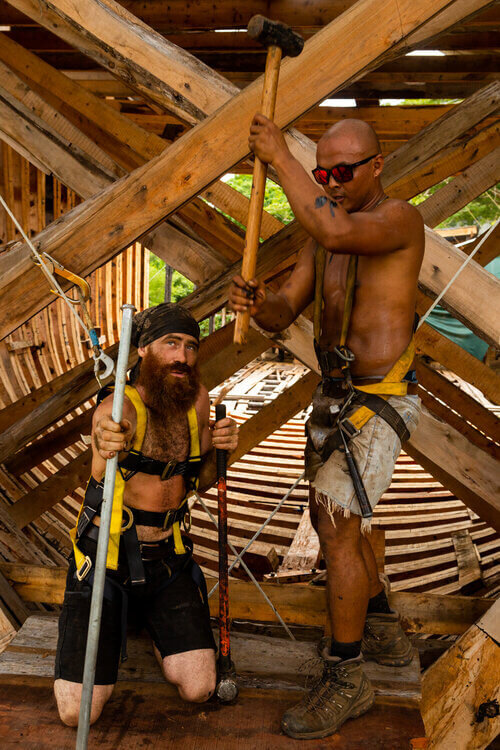What a good Week at the Yard
English
A semi-formal update about the recent progress at the yard, in which several processes are examined: Alaskan chainsaw mill, assembling frames, lofting half and cant frames, and drilling some of the longest holes of the ship.
It’s not often that people from so many backgrounds, with so many unique experiences, can come together to create a single vision – but that seems to be the case at Costa Rica’s eco-shipyard AstilleroVerde. In total the crew have hailed from twenty-five nations, with technical director Lynx Guimond (Quebec) at the helm. In the past months the young and varied team has proven itself: at the time of writing 24 of the massive frames are standing triumphantly, along with the stem, the fore section of the keelson, and nearly all of the deadwood stack. Not including the considerable preparation in place for the following work, this puts the progress at 43% of the frames complete.
SAWYER Henry has done an amazing job with the Alaskan Chainsaw mill, processing countless hardwood timbers.
Milling the hardwood frame timbers is credited to Henry (Costa Rica), who has a special bond with the Alaskan Chainsaw mill and the Stihl 780 that powers it. In the past two weeks the shipyard has received more deliveries of hardwoods than ever before, and the shipyard is an active wood lot. All of the largest and hardest timbers can only be sawn using the chainsaw mill. It is a very challenging job and Henry has impressed the whole team with his ability to run the mill day after day.
SHIP BUILDER Pablo works on the assembly of a frame on the framing stage. A key team member on the stage, Pablo has been with AstilleroVerde since early September.
The tight-knit team on the framing stage is led by Julian Southcott (Australia); the capable crew assemble and raise a frame every five working days (or even less sometimes, they say…!). Once hauled down the ways and prepared, the actual hoist up into place can be as quick as just two minutes. Having just completed construction of an expansion to the framing stage, hopes are high that production can be significantly increased. This expansion doubles the space available to assemble the frames, so two can be built in line. .
MASTER SHIPWRIGHT Pat has advised our project from the beginning, from his home in British Columbia. Pat came down to the shipyard for two weeks to lead the complicated lofting of the special bow section frames.
Welcoming master shipwright Pat Woodland (Canada) to the shipyard for two weeks was highly anticipated. Woodland’s aim was to loft the half frames and cant frames that make up the bow section (frame numbers 49 through 56), and impart his insight. While Woodland has kept in close correspondence since the beginning of the project in an advisory position, he had only visited once before to participate in walking out lines and staking where Ceiba would be founded. As well, the iconic motorcycle-powered tilting ships saw was generously restored at his home in British Columbia before arriving at the shipyard. Lofting the cant frames is particularly challenging as the frames turn to match the convex shape of the hull perpendicularly. Drawing out these expanded views full scale required advanced trigonometry, attention to detail, and experience. Woodland worked closely with several members of the Ceiba crew to ensure that the technique was ingrained, and also gave a workshop to the majority of the team on ways to simplify the complicated expansion process.
“It was a real challenge to drill the hole straight, especially due to the hardwood that we are using – but when you work with the best colleagues everything is easier.”
Impressive achievements have been made at the stem and deadwoods: the dream-team of Nicolas Trochon (France) and Hajatiana Raharijao (Madagascar) have drilled holes for and installed custom galvanized steel bolts that hold the stem assembly together (22mm (7/8ths diameter). These bolts are up to 1,89m (6,2ft) in length. It’s hard to grasp how difficult it was to drill these holes properly. No pilot hole was drilled: instead, the highly-trained duo crafted a guide that was clamped to the outside of the timbers. Nico observed that ‘’the hole was almost perfect and came out very close to the centre-point.’’ Despite already being raised, they had to dig a pit several feet deep below the stem to be able to drill up from the bottom. Climbing out of the pit, they scaled the scaffolding to hammer the tarred-bolts in from above. ‘’We wore harnesses to hammer in the bolts because we were so high up’’ noted Nico. Haja commented, saying ‘’it was a real challenge to drill the hole straight, especially due to the hardwood that we are using – but when you work with the best colleagues everything is easier.’’ The hardwood is much stiffer than the long steel drill-bits, which caused the bit to want to veer off from true, and the variable nature of the grain only exacerbated this effect as the bit wanted to follow the wood rather than stay perfectly straight.
SHIP BUILDERS AT THE STEM Photos above and below. Nico and Haja work together to drill the bolt holes into the hardwood stem, and hit the tarred bolts through. Tar on the bolts is out of the photo. See whole gallery here.
All in all, a good week at the yard!



